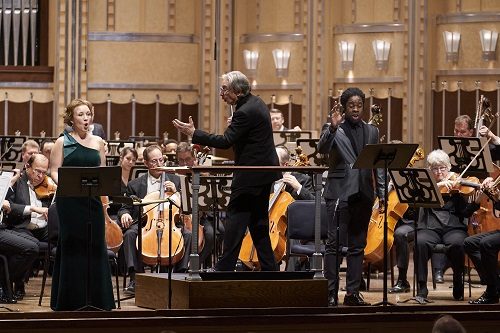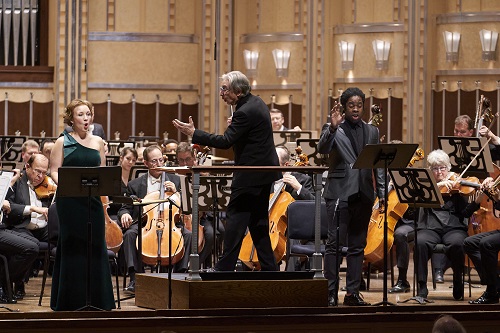 United States Tilson Thomas, Berlioz: Sasha Cooke (mezzo-soprano), Dashon Burton (bass), Cleveland Orchestra / Michael Tilson Thomas (conductor). Severance Hall, Cleveland, 20.2.2020. (MSJ)
United States Tilson Thomas, Berlioz: Sasha Cooke (mezzo-soprano), Dashon Burton (bass), Cleveland Orchestra / Michael Tilson Thomas (conductor). Severance Hall, Cleveland, 20.2.2020. (MSJ)

© Roger Mastroianni
Tilson Thomas – Meditations on Rilke
Berlioz – Symphonie Fantastique
Michael Tilson Thomas has a long relationship with the Cleveland Orchestra, going all the way back to an award-winning recording of Orff’s Carmina Burana in the 1970s, so it was a lovely culmination of his connection with the ensemble to bring his reflective new composition to town. Meditations on Rilke sets poems of the German poet Rainer Maria Rilke in a style that reflects Tilson Thomas’ own interests and career.
The context of the work is set by an unusual introduction: a solo barroom piano (a slightly de-tuned upright played here by Joela Jones) introduces meandering, lyrical orchestral and vocal reflections that sample and emulate the repertory Tilson Thomas has made his home ground over the years, including Schubert, Stravinsky, Copland – and a prominent quote from Mahler’s Fourth Symphony. This ‘sampling’ feature is really the only thing modern about the piece. The rest of it, from a mildly jazzy introduction through Coplandesque sweep, could have been written eighty years ago or more. But then, Tilson Thomas has no pretentions. He doesn’t claim it’s great music, he’s just staking it out as his music: a valedictory overview of his career which has, after all, been focused on music of the past.
The most jarring feature of the work – one which I’m not sure would disappear on repeated hearings – is that the musical context is very different from the poems’ background. It seems odd that the texts are German while the music is clearly American in style, even at its most lyrical. But then, that too is a modern aspect of the piece, reflecting a multicultural world. Whether or not most people range freely between cultures, Tilson Thomas certainly does, and the piece reflects it unapologetically.
Sasha Cooke and Dashon Burton were ideal advocates for the songs, bringing both gorgeous voices and engaging commitment to the work. Tilson Thomas deployed the orchestra with absolute certainty, reflecting his years of experience.
And those years are considerable. I first encountered Tilson Thomas live in concert conducting Hector Berlioz’s Symphonie Fantastique with the Chicago Symphony at Ravinia in 1986. Over the years, his conception of the work has not greatly changed: slow in the lyrical movements, fast in the quick ones. His experience gives him a grasp of the work that controls and normalizes Berlioz’s quirky writing – sometimes too much, but the inflection of important moments at transition spots makes the piece work narratively.
The opening movement was good in that Tilson Thomas made it flow from one idea to the next without letting its disjunct leaps pull it apart. One thing that was different from years ago is the way he restricted the strings’ vibrato early on in the movement, making the performance earn its warmth instead of starting off comfortably there already. The second movement was a little too indulgently opulent, though, never quite charging with the nervous energy required to motivate Berlioz’s program of a hot-headed young artist in love.
The third movement was the least convincing part, as in most performances. The fact is, this movement is the work’s weak point. It is a set of variations on a mediocre theme, one that meant a lot to Berlioz because of personal associations and not because it was good, because it isn’t. The movement ranges widely in ways that are only motivated if Berlioz’s program is considered and, even then, only barely. It takes a lot of focus and control to make this kind of choppy music work, and Tilson Thomas didn’t seem interested in rocking the interpretive boat. He instead polished details and let the music meander along contentedly. The orchestra’s woodwind solos were gorgeous.
The ‘March to the Scaffold’ opened up a little too fast for the timpani players to execute the passage as written by Berlioz: ‘The first quaver of each half-bar to be played with two drumsticks; the other five quavers with the right-hand drumsticks’. The composer didn’t just write this instruction to emphasize the accent over that first quaver. Percussionists can (and did) achieve that emphasis playing normally, with each hand alternating drum beats. Berlioz wrote this peculiar technique to control the speed of the movement, which gets very animated by the end. To me, it seems clear that Berlioz is doing it so that the performance doesn’t take off too fast and become the ‘Race to the Scaffold’. Tilson Thomas and the orchestra are far too accomplished to let the music get away from them, so the conductor started faster than marked and merely controlled the forward push of the march so that it didn’t get too fast. Fair enough. But since there’s an organic acceleration anyway, why not take the composer at his word and actually perform it as written? That quibble aside, it was a dramatic rendition of the march, with an appropriately broadening ending. Afendi Yusuf’s high-floating clarinet solo just before the orchestral guillotine blade drops at the end was breathtaking.
While Tilson Thomas didn’t linger over the atmospheric introduction to the witches’ sabbath finale, the flutes nailed the uncanny glissandos that signal the shift to outright creepiness. From there on it was ghoulishly high spirits, Tilson Thomas letting the brass and percussion cut loose and roar. Happily, low instruments were selected for the tolling bells, and they were offstage, though not very far. The parody of the Dies irae chant was perfectly balanced between tubas and bassoons, and the performance built up a tremendous head of steam in the closing fugue.
Mark Sebastian Jordan
